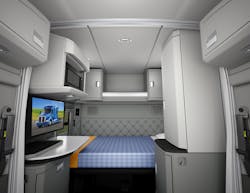Fleets make economic decisions, but what if drivers had full freedom to spec their interiors?
“I’m [only] 5-foot-2, so getting a seat that conforms to me is very important,” said North Carolinian Ingrid Brown, a truck driver since 1979. “I spent maybe $8,000 spec’ing the interior of my truck, including a 3,500-watt power inverter, a 26-in.-mounted television, and a full cabinet package with a built-in business center, but it’s absolutely worth it because I live in my truck. I’m there more than I am in my own bed.”
Indeed, long-haul drivers like Brown are away usually 250-300 nights a year.
“What might be suitable and great for a weekend camping trip or even a week-long camping trip isn’t suitable for us,” said Henry Albert, an owner-operator who has been on the road since 1983 and has added solar power to complement his battery-operated HVAC. “In the past, it was: ‘Build the whole truck and we’ll figure out where we’ll fit the driver.’ [In contrast], my 2018 [Freightliner] Cascadia is by far the most spec’d interior I’ve had. I never thought I would use the table as much as I do, but I fold the bed up every day, and it takes less than 30 seconds to switch it to a dinette. The bed folds out of the wall with an upgraded mattress. In some drivers’ lounges of the past, they wanted you to sleep on four cushions.“
Albert, who is 6 ft. 5 in., was long frustrated by having to look through the uppermost part of the windshield, the area that the wipers couldn’t reach.
“The Cascadias are the first trucks that I haven’t had to have the seat shoved all the way back and be wishing for more [room],” Albert said. “You’d end up cocking your neck a little bit and get a sore neck. I’d rather ride in this truck than in any car on a long trip out on the highway, that’s for sure.”
Albert advised his fellow drivers to buy the premium installation package on their trucks. “It’s worth its weight in gold,” he said. “It quiets the truck down so much, and it makes your HVAC system more efficient. That’s something that gets overlooked by many. [With] what they’ve done with ergonomics, ride quality and quietness of the truck, I can have a reefer back in next to me and it’s just a low drone.”
Ploger Transportation makes sure all of its trucks have a refrigerator, a 5,000-watt inverter, Sirius XM, and premium mattresses.
“There’s nothing worse than sleeping on a standard mattress where you can feel every spring,” said Joel Morrow, a veteran driver with Ploger. “If you don’t sleep at night, you’re not well-rested. A premium mattress is a little pricey, but it’s worth every penny.”
Nussbaum Transportation driver Clark Reed said the best change from his early years behind the wheel is having power, heat and air conditioning without having to idle the truck. “A lot of companies want to go cheap to save a few bucks, but seats make a big difference to driver comfort and fatigue,” he said. “When you live in a truck, those little creature comforts mean a lot.”
Barb Duncan, who returned to driving in 2016 after a 13-year break, said, “If you have a fridge and an inverter, you’ll have better retention. It shows that the company cares about the driver.”
Bernedette Wilson, Duncan’s fellow Canadian, put in a plug for a sink, a rare commodity in a truck because of the need for plumbing. “Being clean is way better,” said Wilson, who like Duncan would love to have a toilet on board so that being turned away from shippers’ restrooms wouldn’t force her to bring along paper cups and a Luggable Loo as portable emergency facilities.
However, OEMs have said that the initial expense and ongoing service costs make providing bathrooms in trucks untenable for fleets. Satellite television and wireless internet are more likely additions on the spec’ing horizon.
“Spec’ing is absolutely getting more attention than it used to,” Morrow said. “Everybody pays just about the same. If you had your choice of two jobs where the pay was almost identical, but one working environment was a lot nicer, where are you gonna go?”




